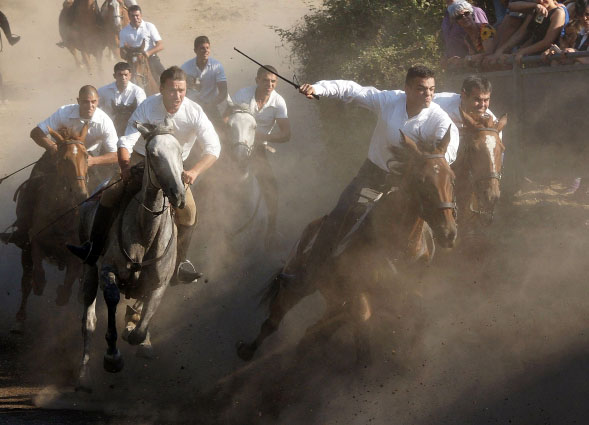The Ardia of Sedilo is one of the most picturesque and fascinating events in Sardinia. The faithful make pilgrimages to Sedilo from all over the island. On July 6th and 7th, the whole community gets together for a celebration, culminating with a thrilling and sometimes reckless horse-race around the Church of San Costantino.
One part horse race, one part religious pilgrimage, this dangerous yearly race is run by brave horsemen atop their faithful steeds, re-enacting the victory of Emperor Constantine, or Costantino il Grande, over his rival, Maxentius in the year 312 in Rome.
In the Battle of the Milvian Bridge, Constantine’s forces obliterated those of Maxentius and rode into Rome in victory. His triumph under the sign of the cross effectively ended the persecutions of Christians in Rome. The bridge where the battle took place still stands in Rome, although a bit changed by time. The battle scene was famously captured in a huge fresco in the Vatican’s Sala di Costantino (Hall of Constantine).
Every year in July, participants in L’Ardia di San Costantino Festival include riders representing Constantine and the Maxentius, costumed flag men and an army doing their best to thwart the efforts of Maxentius. The roles are played by villagers who wait years, even decades, for the privilege.
The Feast consists of two phases. First are the celebrations that take place in the main square of Sedilo, where the parish priest officially appoints the three riders who will receive the pandelas, which are the small flags. One is yellow and is the most important, one is red and the other is white. The riders are dressed in dark jackets, in contrast to their escorts and opposition. The three riders, together with their small army of escorts will have the task of defending the pandelas, which is the second phase of the rite. It begins when the riders head towards Su Fortigheddu, the promontory that overlooks the entrance arch of the sanctuary. Speeches are made by dignitaries, mounted on steeds and the parish priest blesses the flag bearers, then the beautiful and mad race begins around the sanctuary of Santu Antinu.
According to the rite, the first pandela, representing Constantine, must break into a gallop and charge down the hill, close behind will be the second and third pandela, followed by a thundering herd. The two riders, helped by the escorts, will have to prevent the army of Maxentius from passing the Constantine. The escorts and the opposing army all wear white shirts, making it difficult to determine during the heat of the battle which side has the upper hand, but that too is part of the excitement of the event. Will Constantine be victorious?
When they reach the sanctuary, they stop, then circle it slowly, receiving a blessing by the priest each time they pass the front gate – a total of seven times. However, after the sixth pass, Constantine takes off and heads for the finish, leading to a wild sprint to the fountain that marks the end of the race. Many of the army of Maxentius are young men and older boys, while the men carrying the pandela are much older, having waited many years for the honor of carrying the flag. Rather than the strength and vigor of youth, they have guile and surprise on their side. Such is the advantage of maturity. This often places family members on opposing sides, but once the race is on, family bonds are severed until the finish. The end of the race is still always a surprise, but it would be a calamitous event were Constantine not to be the annual winner; after all, a victory means Christianity’s survival for another year. Expect to see plenty of jostling (a kind way of saying maniacal battles) near the front of the pack as the riders head towards the finish! Afterward, the crowd eases toward an open field for a celebration with suckling pigs roasting in wood-fired ovens and skewered eels are cooked over hot coals. The fury of battle among the combatants is forgotten, as families reunite and enjoy a glass of vernaccia wine together, but not too much, this is still a religious observance…sort of.





